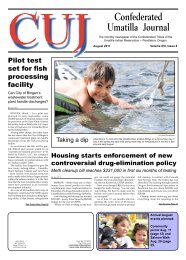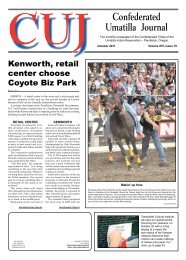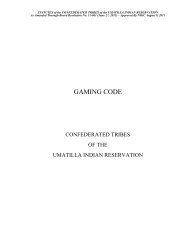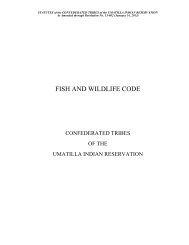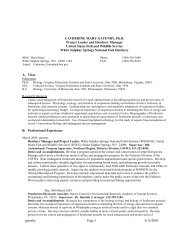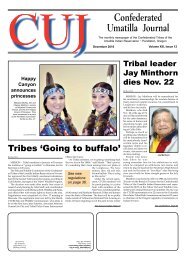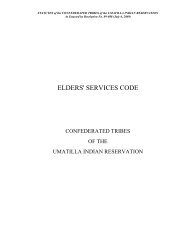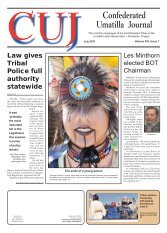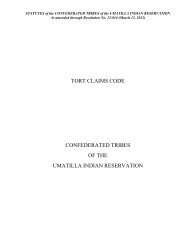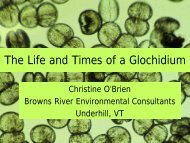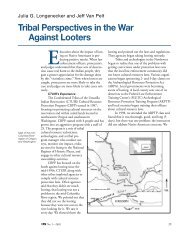November 2011 CUJ - Confederated Tribes of the Umatilla Indian ...
November 2011 CUJ - Confederated Tribes of the Umatilla Indian ...
November 2011 CUJ - Confederated Tribes of the Umatilla Indian ...
- No tags were found...
Create successful ePaper yourself
Turn your PDF publications into a flip-book with our unique Google optimized e-Paper software.
NW solid waste advisorynetwork meeting hereTERF will be on display in presentation, tourPaid Political AdMISSION – The Tribal Solid WasteAdvisory Network, a non-pr<strong>of</strong>it alliance<strong>of</strong> Native American tribes throughout<strong>the</strong> Northwest, will meet here Nov. 8-10at Wildhorse Casino.The agenda on Nov. 9 includes a presentationfrom Bonnie Burke about <strong>the</strong>Tribal Environmental Recovery Facilityon <strong>the</strong> <strong>Umatilla</strong> <strong>Indian</strong> Reservation.Following her presentation, conferenceattendees will tour TERF, and <strong>the</strong>n tour<strong>the</strong> Nixyaawii Governance Center.TSWAN, according to its website,strives to make effective and environmentallyresponsible solid waste managementa priority on reservations andcommunities.One <strong>of</strong> TSWAN’s primary goals is toshare technical expertise, informationand educational resources, and opportunitieswith one ano<strong>the</strong>r, as well as providingTribal perspective to agencies andorganizations designing waste programsso <strong>the</strong>y are effective in <strong>Indian</strong> Country,according to its website.TERF recently was featured in aTSWAN publication. Here’s what <strong>the</strong>article said:In <strong>the</strong> past, tribal members living on <strong>the</strong><strong>Confederated</strong> <strong>Tribes</strong> <strong>of</strong> <strong>the</strong> <strong>Umatilla</strong>’s Reservationin Oregon disposed <strong>of</strong> <strong>the</strong>ir solidwaste in open dumps located across <strong>the</strong>172,000 acre reservation. The municipalsolid waste landfill criteria implementedby EPA in <strong>the</strong> 1990’s (40 Code <strong>of</strong> FederalRegulations 257 and 258) provided insightinto <strong>the</strong> potential harm that <strong>the</strong> open dumpsmay be causing to <strong>the</strong> environment andhealth <strong>of</strong> <strong>the</strong> tribal members.The <strong>Confederated</strong> <strong>Tribes</strong> quickly beganto evaluate o<strong>the</strong>r solid waste managementalternatives. Options includedusing rail to move waste to a regulatedlandfill, incineration or installing a newtransfer station. They determined thata transfer station would be <strong>the</strong> best optionfor eliminating open dumping on <strong>the</strong>reservation.Construction <strong>of</strong> <strong>the</strong> transfer station tookplace from 1999 to 2001 at a cost <strong>of</strong> $1.3million. It was financed, in part, by federalgovernment funding. The 13,000 squarefoottransfer station was built by a triballyowned construction company. Waste isei<strong>the</strong>r collected curbside or hauled by residentsto <strong>the</strong> transfer station seven days aweek. The waste is <strong>the</strong>n processed andtransported to an EPA-approved landfilllocated 55 miles away.Recyclables and household hazardouswaste are collected, sorted, and stockpiledon site and transferred to <strong>of</strong>f-site facilities.The minimum fee charged is $8 per bagto take out waste less than 200 poundsor $55 per ton, which remains competitiveamong o<strong>the</strong>r area transfer stations.Currently, <strong>the</strong> transfer station serves 900residents and 93 commercial customersthroughout <strong>the</strong> reservation. The transferstation is currently 1,500 tons short <strong>of</strong>reaching <strong>the</strong> optimum operation efficiencylevel <strong>of</strong> 6,000 tons.Bonnie Burke, Operation Manager for<strong>the</strong> Tribal Environmental Recovery Facility(TERF), launched an education andoutreach campaign focused on <strong>the</strong> benefits<strong>of</strong> using <strong>the</strong> transfer station. The campaigneducated people on <strong>the</strong> hazards <strong>of</strong> opendumping and <strong>the</strong> effects it has on bothhuman health and <strong>the</strong> environment. Thecampaign also helped ease <strong>the</strong> transition toreducing solid waste by recycling. Targetedoutreach and education to both tribal eldersand children was a critical component <strong>of</strong>Burke’s campaign.Burke is conducting a survey <strong>of</strong> <strong>the</strong> participatingtribal elders requesting feedbackon <strong>the</strong> success <strong>of</strong> <strong>the</strong> curbside recyclingprogram. <strong>Umatilla</strong> is also working withan intern to run an afterschool program toeducate school children on recycling. Overa period <strong>of</strong> 10 years, <strong>the</strong> amount <strong>of</strong> wastecollected has increased by 4,000 tons dueto <strong>the</strong> TERF staff’s determination and outreachand education efforts.NOW - Dec. 3 - Crow’s Shadow print exhibition at Humboldt State University inArcata, CANOW - April 20, 2012 - Crow’s Shadow print exhibition at PDX International Airport.Nov. 4-6 - Cylindrical and flat bag weaving workshop with Joey Lavador at Crow’sShadowDec. 3-4 - Medallion beading workshop with Maynard Lavadour at Crow’s Shadow.Dec. 4-17 - Printmaking residency with artist Janene NagyDec. 15 - Artist reception and lecture presentation with Janene Nagy, 5:30-7:30Please check our website at www.crowsshadow.org or call 541-276-3954.Become a fan <strong>of</strong> Crow’s Shadow on FacebookCrow’s Shadow Schedule48004 St. Andrews Road, Pendleton, OR 97801 - 541-276-3954<strong>November</strong> <strong>2011</strong><strong>Confederated</strong> <strong>Umatilla</strong> Journal39



